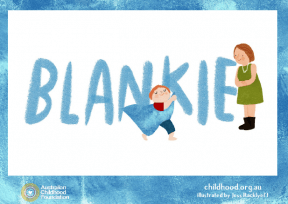
Blue blankie: Considering therapeutic objects in the lives of children
‘Blue Blankie: Considering therapeutic objects in the lives of children’ blog article was written by Chris Cussen, Product Development, Content Creation, and Projects Lead from the Therapeutic Services Team at Australian Childhood Foundation.
Our son has a blue blanket that has been a part of his life since he was very little. To the outsider’s eyes, it might look a bit shabby and misshapen, but not to those in our family. ‘Blue blankie’ was first used as my son’s cot blanket its soft touch helping to ease him to sleep as we watched him through the slats of his cot. When he woke in the night, I would walk the lengths of the loungeroom with him in my arms swathed by blue blankie, singing gentle songs to soothe both of us. His dad used to swaddle him in the blue blankie ‘like fish and chips’ while they would sit together on the couch and watch the footy or Paw Patrol on television.
My son had other blankets and soft toys, but somehow it is blue blankie that matters the most. Blue blankie has been there through colds and COVID-19, through long nights, and extended car trips. It has eased him through transitions and vulnerable feelings. He has used it to wrap around his toys, perhaps to extend to them the comfort it offers him. He has donated it to family members at times when he noticed we were unwell or resting. This blanket has been a repository of affection, hugs and hopes, snot and tears over the years. It continues to look, smell, and feel special to him. Our family has shared care and comfort through blue blankie, and this piece of fabric is infused with our love no matter how tattered it becomes.
Has there been a toy or object infused with the same love and care in your life? Perhaps you have an object that is dear to you from your childhood, or there is a child in your life who has an item that is special to them?
Parents, carers and professionals have long been intrigued by the way some children form strong relationships with items like blankets. This phenomenon has been researched and understood in various ways over the years. Winnicott’s notion of a blankie as a ‘transitional object’ or a child’s first ‘not me’ possession is well-known. In the early 1950s he put forward the idea that a child transfers the soothing properties of the mother to an object, and then through the use of that object they develop self-soothing capacities. For me, I like the way Mahler thought about it. She thought that the value of what she terms ‘the therapeutic object’ lies in its ability to allow the infant to move away from the mother physically and hold on to a part of her at the same time.
Some parents and carers can become a little wary when their child’s connection with their blankie or another item remains strong as they age. Research has shown however, that seeking comfort with their item may boost a child’s confidence and help them to cope better with the challenges they face. Other research by Litt has also shown that children who develop attachments to inanimate objects have a higher overall level of emotional adjustment. Overall, there is general agreement among researchers that ‘blankies’ or similar objects are healthy attachments that children make with comforting objects when they are young.
Items like blue blankie become a part of a child’s support system. The item becomes special because of its relational use and the way it is imbued with love and sensory cues associated with care and comfort. It is an object attached to warm relational memories that a child will carry with them even after they grow out of it or it falls apart. Children come to internalise the properties of blankies, giving them another way to stay in contact with those important people who have provided them care and comfort as they move through life.
References
Litt, C.J. (1986) Theories of Transitional Object Attachment: An Overview. International Journal of Behavioural Development 9 pp. 383-399
Mahler, M. (1972) On the first three subphases of the separation-individuation process. International Journal of Psychoanalysis. 53, 333-338
Winnicott, D.W., 1953. Transitional objects and transitional phenomena. International Journal of Psychoanalysis. 34, 89-97
Trauma Professionals Online Learning Community
Join our Trauma Professionals Online Learning Community to download more resources like this one.

